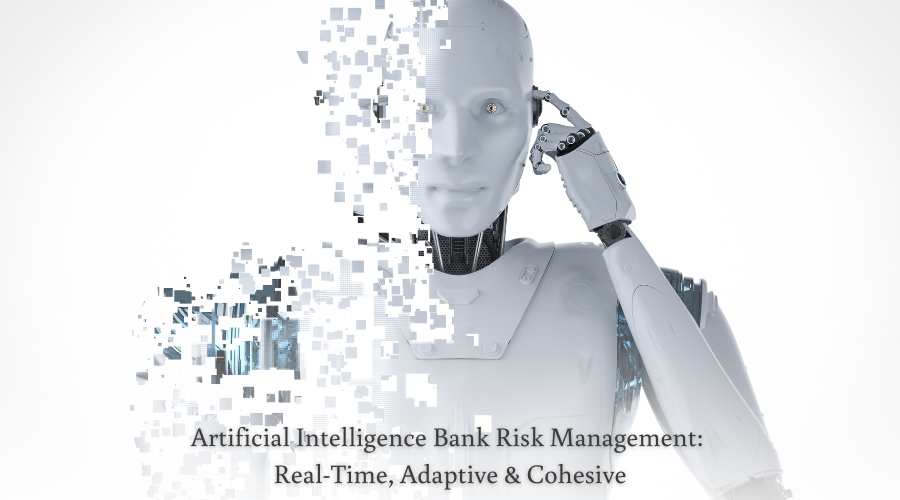Bank risk is managed today within silos of expertise, each using their own specific models, technology, and practices.
But Artificial Intelligence is changing the way banks (and the world) are doing business.
AI is already found in many risk areas as integrated technical functionality, such as fraud monitoring and cyber security monitoring.
The real risk transformation will occur when all risk areas are under one artificial intelligence, providing a real-time, adaptive and cohesive view of bank risk.
Here’s an example: it’s not unusual for a financial contagion risk to invalidate credit models, raising credit and liquidity risks and throwing the bank out compliance. Using risk management tools available today, this would take weeks to understand and months to remediate.
Take this same example using Artificial Intelligence:
- AI will recognize the financial market contagion real time via social media
- proactively adjust credit risk models
- make a call for liquidity to keep the bank in compliance
People will still be involved in the decision-making process, but it all happens within hours – not weeks.
Sounds like science fiction, right?
It’s not. Here are some ways AI is already enhancing risk management within bank risk silos:
Credit Risk & AI
Credit risk is based on the potential loss suffered when borrowers or counterparties fail to make payments on debts. Banks are using AI and natural language processing technologies to conduct more expansive, thorough probability-of-default analysis, as well as enhance their detection of early warning signs.
Artificial Intelligence Forecasts Market Risk
As capital markets fluctuate, banks face considerable threats to their bottom line. To keep pace with fast-moving market factors, banks use AI tools to forecast trends and enhance decision-making.
For example, a bank might use an AI tool to analyze massive amounts of social media activity and determine the current consumer sentiment about a particular market. This data can then be used to predict the corresponding market activity or investment strategy.
AI Addresses Operational Risk
Operational risk refers to the risk of loss due to inadequate internal systems or processes, as well as loss from system breaches or service interruptions. To address this risk, AI can ingest massive amounts of data—including unstructured data like written risk reports—to help banks spot areas for improvement and identify where outside factors pose the most significant risk.
Artificial Intelligence Mitigates Model Risk
Banks use a variety of models to make predictions and plan their activities. But what happens when one of these guiding models is wrong? This risk is referred to as model risk. To mitigate it, banks use AI to monitor other ML and AI systems and identify algorithm bias, fairness, inaccuracy, and misuse.
AI Identifies Cybersecurity Risk
In our increasingly connected world, banks face cybersecurity threats from more attack vectors than ever. To detect malicious activity and mitigate risks, they use AI to identify anomalies on IT systems and predict attacker behavior, such as target choice or infiltration method.
How AI Applies to Contagion Risk
Banks also face the risk of other economic effects harming their business—such as a financial crash in a foreign market influencing an existing loan agreement, or the global market impacts caused by the COVID-19 pandemic. AI is applied in this instance to help banks understand the potential impacts, spot warning signs from other banks, and determine the appropriate mitigation measures.
Banks Use AI to Detect Compliance Risk
Regulatory compliance is a rigorous and complex process for banks. They constantly face the risk of legal sanctions, financial loss, or negative impacts on their reputations due to failure to comply with laws and standards.
To mitigate this risk, many banks are looking to confidential computing technologies that help streamline compliance while dramatically improving the security of sensitive workloads and data. Banks also use AI technologies to detect compliance gaps and ensure adherence to guidelines.
AI: The Wave of the Future for Banks
AI is the only way for banks to manage and compete against advancing risk trends that indicate:
- Regulation will continue to broaden and deepen.
- Customer expectations are rising in line with changing technology.
- Technology and advanced analytics are evolving (competitors and imposters are using AI as well).
- New risks are emerging. For example, old risks were events such as war, while today fakes, imposters and bad actors comprise the new risks.
- Human and institutional bias are becoming riskier.
Obviously, a bank cannot defend itself against other’s AI (competitor or bad actor) without its own AI. Over time, customers will eventually come to prefer AI customer service over CSRs. Human bias risks will only become more expensive. War is a very real human event – and risks are ever evolving.
How prepared is your organization for the changes that are looming? I specialize in banking technology, deciphering the elements that work collectively towards progress – and building a roadmap for successful execution.
Let’s talk strategy! Setup a time to discuss your goals.

